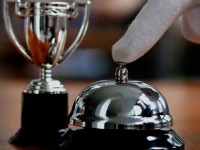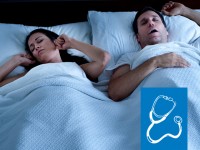Our thanks to regular contributor, Unified Healthcare Group (UHG), for a fantastic article on sleep apnoea – a complaint suffered by hundreds of thousands of Australians, which naturally includes many of your clients…
“Stop snoring!”
Ever been awoken by these words or shouted them at a bed partner? Whether or not we realise it, most people snore at some point. But sometimes it’s more than a night-time nuisance to forget the morning after and requires medical investigation. In fact, chronic snoring may be associated with a sleep-related breathing disorder, such as sleep apnoea.

What is sleep apnoea?
Sleep apnoea is a sleep disorder in which breathing keeps stopping and starting. There are two main forms:
- Obstructive sleep apnoea – the throat muscles relax, closing the airway as a person inhales. The brain senses this breathing difficulty and wakes the person so he or she can reopen the airway. Sleep is interrupted so briefly that the person may not remember it.
- Central sleep apnoea – the brain fails to send signals to the muscles that control breathing, most commonly because of heart failure or stroke. People with central sleep apnoea are more likely to remember this interruption to their sleep.
Obstructive sleep apnoea is more common than central sleep apnoea, but their symptoms overlap. This can make it hard to determine which one is present. Common symptoms of these sleep apnoeas include:
- Extreme daytime sleepiness
- Loud snoring – this is more obvious in obstructive sleep apnoea
- Pauses in breathing during sleep
- Shortness of breath that wakes the sleeper suddenly – this is more likely in central sleep apnoea
- Morning headaches
- Trouble remaining asleep (insomnia)
- Problems paying attention
What causes sleep apnoea?
Sleep apnoea may affect anyone, but some factors can increase the risk. The risk factors for obstructive sleep apnoea include:
- Being overweight or obese
- A wide neck
- A narrow airway, which is inherited or due to enlarged tonsils or adenoids
- Being male
- Being older than 60 years
- A family history of sleep apnoea
- Some drugs (eg: alcohol, sedatives, tranquilisers)
- Smoking
- Nasal congestion due to physiological problems or allergies
The risk factors for central sleep apnoea include:
- Being male
- Being older than 65 years
- Heart disorders (eg: atrial fibrillation, congestive heart failure)
- Stroke or brain tumour
- A wide neck
Some sleep apnoea risk factors, such as increasing age, can’t be controlled, but a doctor may provide help in addressing those that can be changed (see: ‘How is sleep apnoea treated?’).
Is sleep apnoea dangerous?
Many people may dismiss some sleep apnoea symptoms, such as loud snoring or morning headaches, as a nuisance. However, sleep apnoea can result in low blood oxygen levels during sleep and is a potentially serious medical condition. The complications may include:
- High blood pressure generally (hypertension) or in the lungs (pulmonary hypertension)
- Heart problems (eg: atrial fibrillation, congestive heart failure)
- Coronary artery disease
- Extreme daytime sleepiness
- Problems taking some medications and general anaesthetic
- Problems after surgery because of breathing difficulties
Sleep apnoea may also be associated with complaints, such as:
- Relationship problems when loud snoring deprives others of sleep
- Memory or concentration problems
- Morning headaches
- Mood swings or depression
- A frequent need to urinate at night
- Decreased interest in sex
Furthermore, fatigue resulting from sleep apnoea may increase the risk of an accident when operating a vehicle or machinery, according to sleep disorder centre SNORE Australia.
The good news is that treatments are available to help those with sleep apnoea lead healthy, active lives.
How is sleep apnoea treated?
The treatments for sleep apnoea depend on the form a person has, its severity and its causes, among other factors.
Treatment for obstructive sleep apnoea
An effective treatment for obstructive sleep apnoea is nasal continuous positive airway pressure (CPAP, pronounced ‘see pap’), states SNORE Australia.
CPAP uses a small machine that pumps air under gentle pressure to a mask covering the mouth and/or nose. This pressure keeps the airway open and prevents it from closing during sleep.
A CPAP machine neither breathes for the user, nor provides extra oxygen. By keeping the airway open, it lets the person breathe normally. However, be aware that CPAP does not cure obstructive sleep apnoea, but rather, treats the symptoms. If a person stops this treatment, the snoring and obstructive sleep apnoea symptoms will return.
CPAP may take time to adjust to, but after starting this treatment, snoring, daytime sleepiness and other symptoms may improve immediately or gradually.
Initially, discomfort may be experienced when using CPAP masks and equipment but this generally passes within a few weeks. Other potential side-effects include:
- A dry mouth or nasal passages
- Skin irritation where the mask is placed
- A sense of high air pressure through the mask
- Reflux
- Abdominal bloating
While these symptoms are uncommon, they may be overcome, states SNORE Australia. A sleep specialist or CPAP equipment supplier should be able to address any concerns. Also, be aware that CPAP needs may change over time, so users need to be reassessed regularly.
Importantly, lifestyle changes may help reduce the severity of obstructive sleep apnoea to the extent that CPAP is no longer needed, according to SNORE Australia. These changes may involve:
- Losing weight
- Limiting night-time use of alcohol or sedatives
- Learning to sleep only on your side
- Developing good sleep habits
- Quitting smoking
Other treatment options for obstructive sleep apnoea are available. A sleep specialist can provide individual advice about treatment plans.
Treatment of central sleep apnoea
Treatments for central sleep apnoea depend on what is making the person’s breathing unstable.
If a heart problem is causing the sleep apnoea, this must be treated first.
If both central and obstructive sleep apnoeas are present, CPAP treatment may be used. Some CPAP machines monitor breathing non-stop and make abnormal breathing less severe. A sleep specialist can provide individual treatment advice.
When to seek help
Consult a doctor if you or your bed partner experience any potential signs of sleep apnoea or other conditions. These may include: loud snoring, especially if accompanied by pauses in breathing; shortness of breath that wakes the sleeper; extreme daytime sleepiness; and irritability. Remember that the information contained in this article is of a general nature and intended as a guide only. For individual advice, consult your doctor or other appropriate health professional.

The Waiting Room looks at of some of the common medical conditions which advisers may come across when dealing with clients.
Unified Healthcare Group serves Australia’s financial services industry by providing a one-stop solution for all medical requirements associated with life insurance claims and underwriting.
Contact or follow the author: Telephone: 1300 558 583 | Website | Email | LinkedIn















